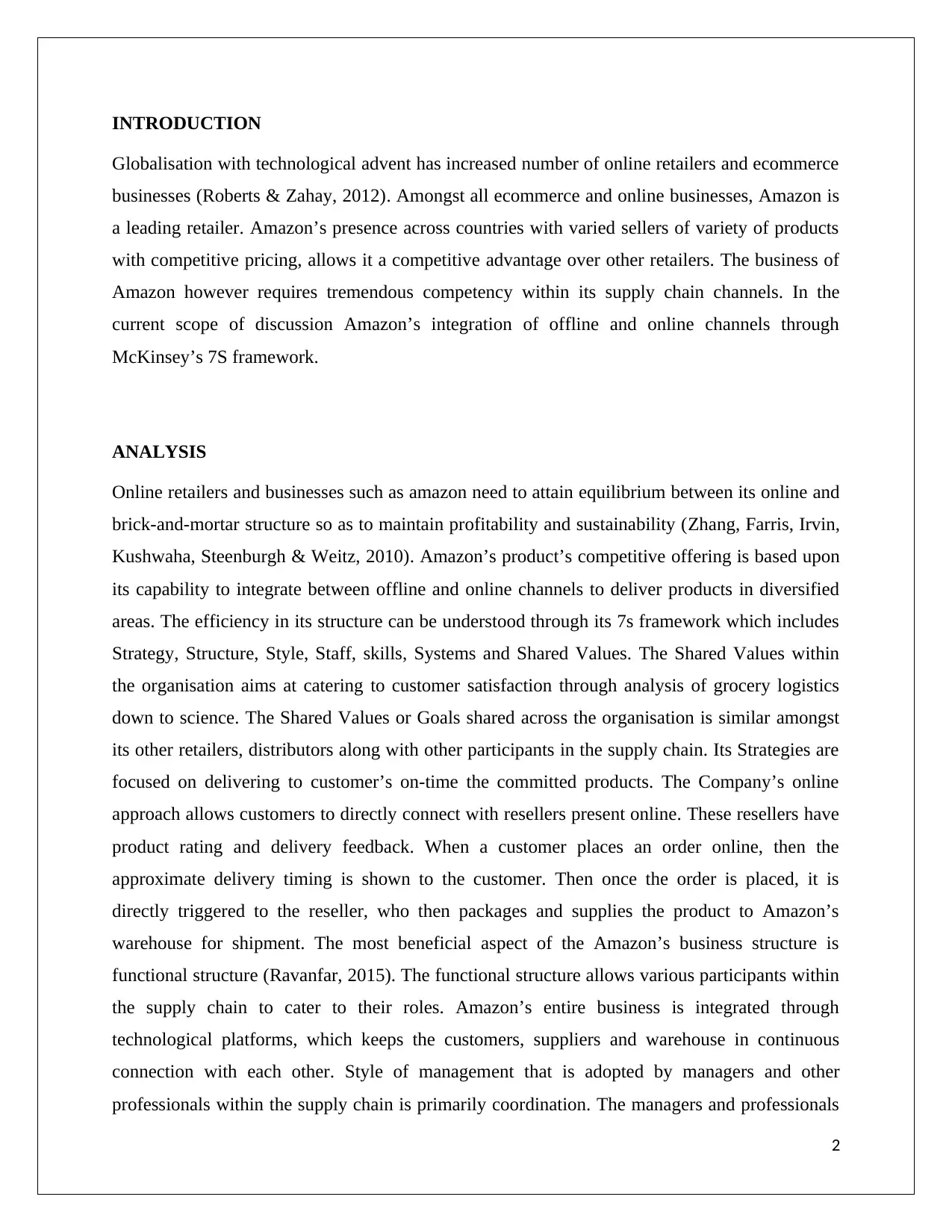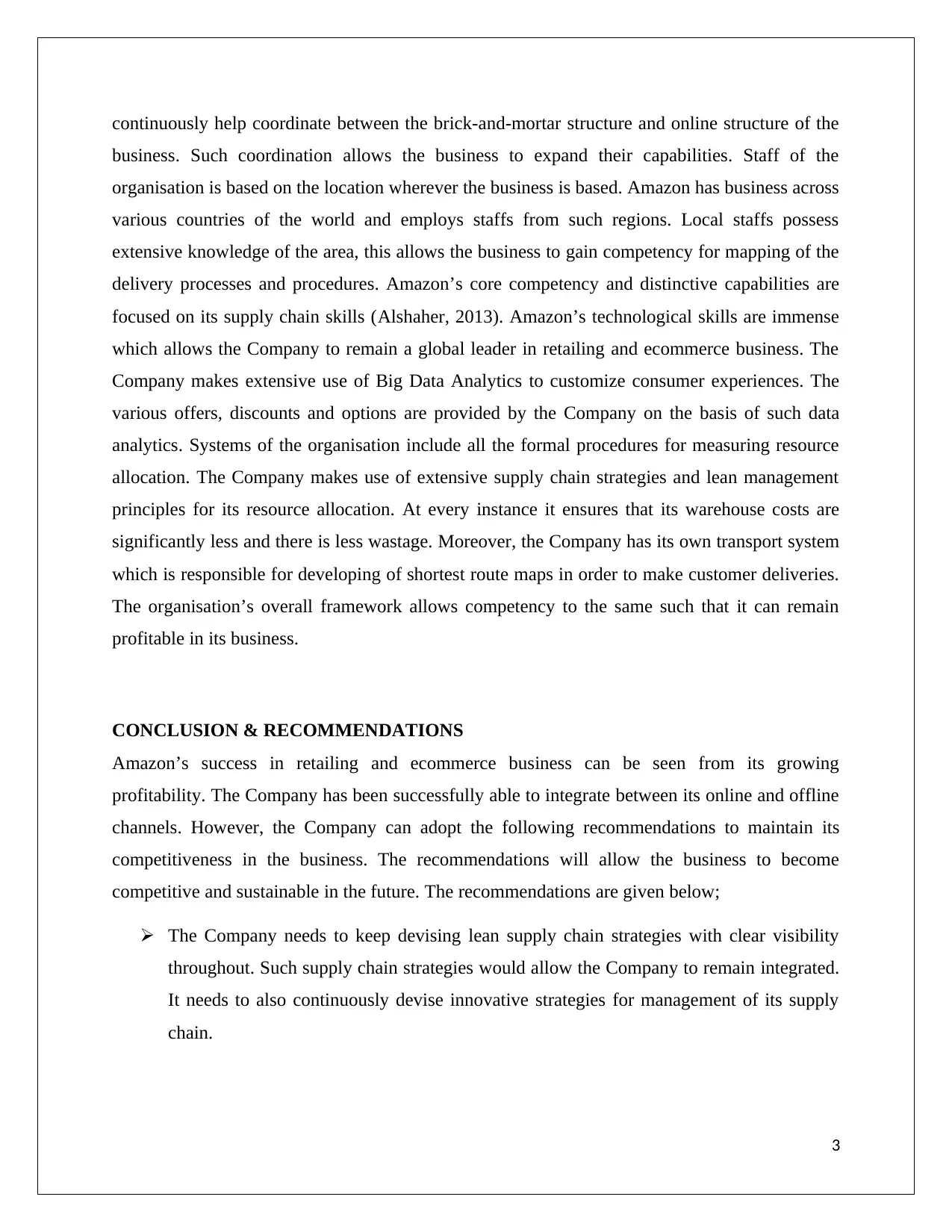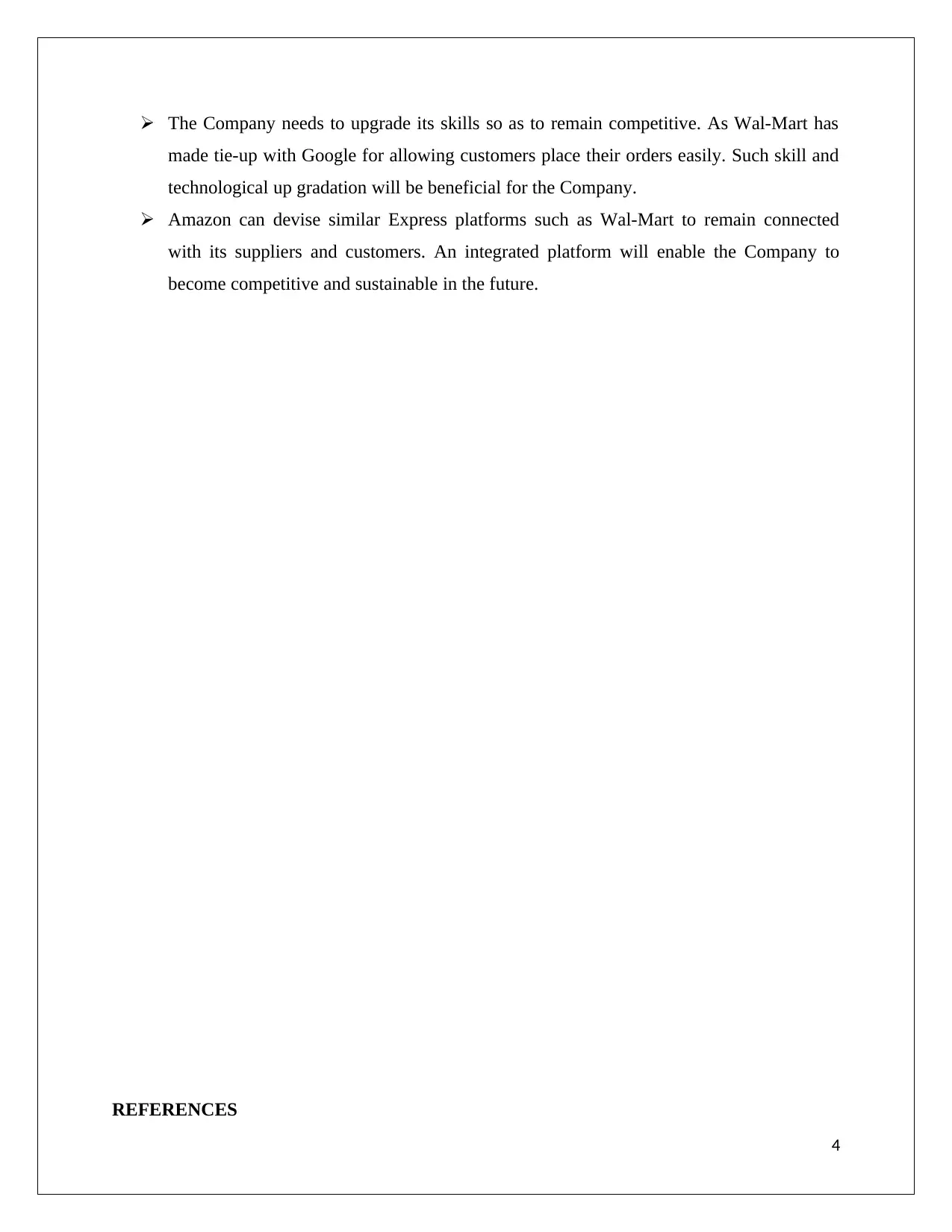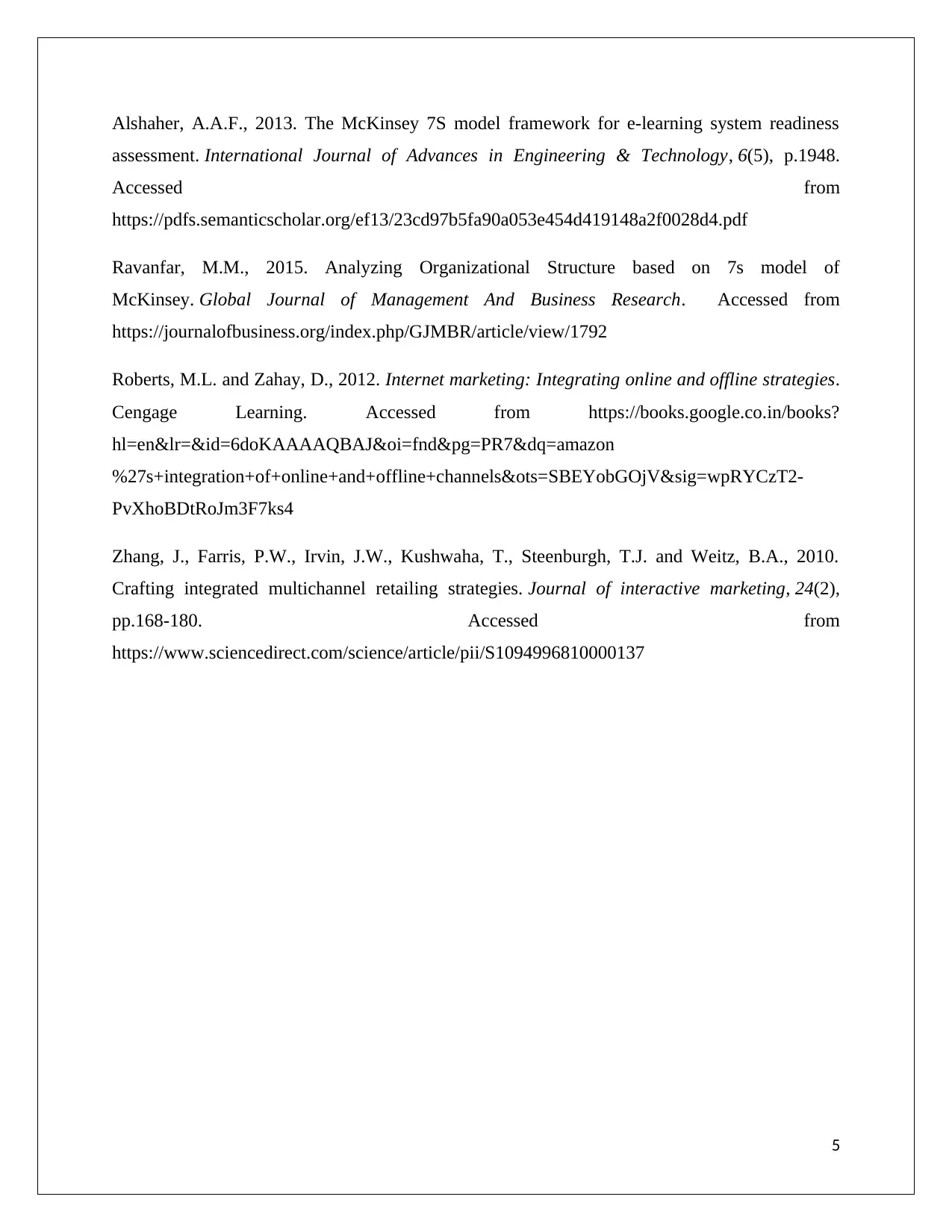Amazon's Integration Strategy: Offline and Online Channels Analysis
VerifiedAdded on 2023/06/03
|5
|1038
|73
Report
AI Summary
This report examines Amazon's integration of offline and online channels within the context of the McKinsey 7S framework. It analyzes Amazon's strategic approach to achieving equilibrium between its online and brick-and-mortar presence, emphasizing the importance of supply chain competency. The analysis delves into each element of the 7S framework: Strategy, Structure, Style, Staff, Skills, Systems, and Shared Values, highlighting how Amazon leverages technology and functional structures to enhance customer satisfaction and streamline operations. The report emphasizes the role of technological platforms in connecting customers, suppliers, and warehouses. It also recommends strategies to maintain competitiveness, including lean supply chain strategies, skill upgrades, and integrated platforms. The conclusion underscores Amazon's success and suggests further steps for future sustainability.

AMAZON’S INETGRATION OF OFFLINE AND ONLINE CHANNELS
1
1
Paraphrase This Document
Need a fresh take? Get an instant paraphrase of this document with our AI Paraphraser

INTRODUCTION
Globalisation with technological advent has increased number of online retailers and ecommerce
businesses (Roberts & Zahay, 2012). Amongst all ecommerce and online businesses, Amazon is
a leading retailer. Amazon’s presence across countries with varied sellers of variety of products
with competitive pricing, allows it a competitive advantage over other retailers. The business of
Amazon however requires tremendous competency within its supply chain channels. In the
current scope of discussion Amazon’s integration of offline and online channels through
McKinsey’s 7S framework.
ANALYSIS
Online retailers and businesses such as amazon need to attain equilibrium between its online and
brick-and-mortar structure so as to maintain profitability and sustainability (Zhang, Farris, Irvin,
Kushwaha, Steenburgh & Weitz, 2010). Amazon’s product’s competitive offering is based upon
its capability to integrate between offline and online channels to deliver products in diversified
areas. The efficiency in its structure can be understood through its 7s framework which includes
Strategy, Structure, Style, Staff, skills, Systems and Shared Values. The Shared Values within
the organisation aims at catering to customer satisfaction through analysis of grocery logistics
down to science. The Shared Values or Goals shared across the organisation is similar amongst
its other retailers, distributors along with other participants in the supply chain. Its Strategies are
focused on delivering to customer’s on-time the committed products. The Company’s online
approach allows customers to directly connect with resellers present online. These resellers have
product rating and delivery feedback. When a customer places an order online, then the
approximate delivery timing is shown to the customer. Then once the order is placed, it is
directly triggered to the reseller, who then packages and supplies the product to Amazon’s
warehouse for shipment. The most beneficial aspect of the Amazon’s business structure is
functional structure (Ravanfar, 2015). The functional structure allows various participants within
the supply chain to cater to their roles. Amazon’s entire business is integrated through
technological platforms, which keeps the customers, suppliers and warehouse in continuous
connection with each other. Style of management that is adopted by managers and other
professionals within the supply chain is primarily coordination. The managers and professionals
2
Globalisation with technological advent has increased number of online retailers and ecommerce
businesses (Roberts & Zahay, 2012). Amongst all ecommerce and online businesses, Amazon is
a leading retailer. Amazon’s presence across countries with varied sellers of variety of products
with competitive pricing, allows it a competitive advantage over other retailers. The business of
Amazon however requires tremendous competency within its supply chain channels. In the
current scope of discussion Amazon’s integration of offline and online channels through
McKinsey’s 7S framework.
ANALYSIS
Online retailers and businesses such as amazon need to attain equilibrium between its online and
brick-and-mortar structure so as to maintain profitability and sustainability (Zhang, Farris, Irvin,
Kushwaha, Steenburgh & Weitz, 2010). Amazon’s product’s competitive offering is based upon
its capability to integrate between offline and online channels to deliver products in diversified
areas. The efficiency in its structure can be understood through its 7s framework which includes
Strategy, Structure, Style, Staff, skills, Systems and Shared Values. The Shared Values within
the organisation aims at catering to customer satisfaction through analysis of grocery logistics
down to science. The Shared Values or Goals shared across the organisation is similar amongst
its other retailers, distributors along with other participants in the supply chain. Its Strategies are
focused on delivering to customer’s on-time the committed products. The Company’s online
approach allows customers to directly connect with resellers present online. These resellers have
product rating and delivery feedback. When a customer places an order online, then the
approximate delivery timing is shown to the customer. Then once the order is placed, it is
directly triggered to the reseller, who then packages and supplies the product to Amazon’s
warehouse for shipment. The most beneficial aspect of the Amazon’s business structure is
functional structure (Ravanfar, 2015). The functional structure allows various participants within
the supply chain to cater to their roles. Amazon’s entire business is integrated through
technological platforms, which keeps the customers, suppliers and warehouse in continuous
connection with each other. Style of management that is adopted by managers and other
professionals within the supply chain is primarily coordination. The managers and professionals
2

continuously help coordinate between the brick-and-mortar structure and online structure of the
business. Such coordination allows the business to expand their capabilities. Staff of the
organisation is based on the location wherever the business is based. Amazon has business across
various countries of the world and employs staffs from such regions. Local staffs possess
extensive knowledge of the area, this allows the business to gain competency for mapping of the
delivery processes and procedures. Amazon’s core competency and distinctive capabilities are
focused on its supply chain skills (Alshaher, 2013). Amazon’s technological skills are immense
which allows the Company to remain a global leader in retailing and ecommerce business. The
Company makes extensive use of Big Data Analytics to customize consumer experiences. The
various offers, discounts and options are provided by the Company on the basis of such data
analytics. Systems of the organisation include all the formal procedures for measuring resource
allocation. The Company makes use of extensive supply chain strategies and lean management
principles for its resource allocation. At every instance it ensures that its warehouse costs are
significantly less and there is less wastage. Moreover, the Company has its own transport system
which is responsible for developing of shortest route maps in order to make customer deliveries.
The organisation’s overall framework allows competency to the same such that it can remain
profitable in its business.
CONCLUSION & RECOMMENDATIONS
Amazon’s success in retailing and ecommerce business can be seen from its growing
profitability. The Company has been successfully able to integrate between its online and offline
channels. However, the Company can adopt the following recommendations to maintain its
competitiveness in the business. The recommendations will allow the business to become
competitive and sustainable in the future. The recommendations are given below;
The Company needs to keep devising lean supply chain strategies with clear visibility
throughout. Such supply chain strategies would allow the Company to remain integrated.
It needs to also continuously devise innovative strategies for management of its supply
chain.
3
business. Such coordination allows the business to expand their capabilities. Staff of the
organisation is based on the location wherever the business is based. Amazon has business across
various countries of the world and employs staffs from such regions. Local staffs possess
extensive knowledge of the area, this allows the business to gain competency for mapping of the
delivery processes and procedures. Amazon’s core competency and distinctive capabilities are
focused on its supply chain skills (Alshaher, 2013). Amazon’s technological skills are immense
which allows the Company to remain a global leader in retailing and ecommerce business. The
Company makes extensive use of Big Data Analytics to customize consumer experiences. The
various offers, discounts and options are provided by the Company on the basis of such data
analytics. Systems of the organisation include all the formal procedures for measuring resource
allocation. The Company makes use of extensive supply chain strategies and lean management
principles for its resource allocation. At every instance it ensures that its warehouse costs are
significantly less and there is less wastage. Moreover, the Company has its own transport system
which is responsible for developing of shortest route maps in order to make customer deliveries.
The organisation’s overall framework allows competency to the same such that it can remain
profitable in its business.
CONCLUSION & RECOMMENDATIONS
Amazon’s success in retailing and ecommerce business can be seen from its growing
profitability. The Company has been successfully able to integrate between its online and offline
channels. However, the Company can adopt the following recommendations to maintain its
competitiveness in the business. The recommendations will allow the business to become
competitive and sustainable in the future. The recommendations are given below;
The Company needs to keep devising lean supply chain strategies with clear visibility
throughout. Such supply chain strategies would allow the Company to remain integrated.
It needs to also continuously devise innovative strategies for management of its supply
chain.
3
⊘ This is a preview!⊘
Do you want full access?
Subscribe today to unlock all pages.

Trusted by 1+ million students worldwide

The Company needs to upgrade its skills so as to remain competitive. As Wal-Mart has
made tie-up with Google for allowing customers place their orders easily. Such skill and
technological up gradation will be beneficial for the Company.
Amazon can devise similar Express platforms such as Wal-Mart to remain connected
with its suppliers and customers. An integrated platform will enable the Company to
become competitive and sustainable in the future.
REFERENCES
4
made tie-up with Google for allowing customers place their orders easily. Such skill and
technological up gradation will be beneficial for the Company.
Amazon can devise similar Express platforms such as Wal-Mart to remain connected
with its suppliers and customers. An integrated platform will enable the Company to
become competitive and sustainable in the future.
REFERENCES
4
Paraphrase This Document
Need a fresh take? Get an instant paraphrase of this document with our AI Paraphraser

Alshaher, A.A.F., 2013. The McKinsey 7S model framework for e-learning system readiness
assessment. International Journal of Advances in Engineering & Technology, 6(5), p.1948.
Accessed from
https://pdfs.semanticscholar.org/ef13/23cd97b5fa90a053e454d419148a2f0028d4.pdf
Ravanfar, M.M., 2015. Analyzing Organizational Structure based on 7s model of
McKinsey. Global Journal of Management And Business Research. Accessed from
https://journalofbusiness.org/index.php/GJMBR/article/view/1792
Roberts, M.L. and Zahay, D., 2012. Internet marketing: Integrating online and offline strategies.
Cengage Learning. Accessed from https://books.google.co.in/books?
hl=en&lr=&id=6doKAAAAQBAJ&oi=fnd&pg=PR7&dq=amazon
%27s+integration+of+online+and+offline+channels&ots=SBEYobGOjV&sig=wpRYCzT2-
PvXhoBDtRoJm3F7ks4
Zhang, J., Farris, P.W., Irvin, J.W., Kushwaha, T., Steenburgh, T.J. and Weitz, B.A., 2010.
Crafting integrated multichannel retailing strategies. Journal of interactive marketing, 24(2),
pp.168-180. Accessed from
https://www.sciencedirect.com/science/article/pii/S1094996810000137
5
assessment. International Journal of Advances in Engineering & Technology, 6(5), p.1948.
Accessed from
https://pdfs.semanticscholar.org/ef13/23cd97b5fa90a053e454d419148a2f0028d4.pdf
Ravanfar, M.M., 2015. Analyzing Organizational Structure based on 7s model of
McKinsey. Global Journal of Management And Business Research. Accessed from
https://journalofbusiness.org/index.php/GJMBR/article/view/1792
Roberts, M.L. and Zahay, D., 2012. Internet marketing: Integrating online and offline strategies.
Cengage Learning. Accessed from https://books.google.co.in/books?
hl=en&lr=&id=6doKAAAAQBAJ&oi=fnd&pg=PR7&dq=amazon
%27s+integration+of+online+and+offline+channels&ots=SBEYobGOjV&sig=wpRYCzT2-
PvXhoBDtRoJm3F7ks4
Zhang, J., Farris, P.W., Irvin, J.W., Kushwaha, T., Steenburgh, T.J. and Weitz, B.A., 2010.
Crafting integrated multichannel retailing strategies. Journal of interactive marketing, 24(2),
pp.168-180. Accessed from
https://www.sciencedirect.com/science/article/pii/S1094996810000137
5
1 out of 5
Related Documents
Your All-in-One AI-Powered Toolkit for Academic Success.
+13062052269
info@desklib.com
Available 24*7 on WhatsApp / Email
![[object Object]](/_next/static/media/star-bottom.7253800d.svg)
Unlock your academic potential
Copyright © 2020–2025 A2Z Services. All Rights Reserved. Developed and managed by ZUCOL.





